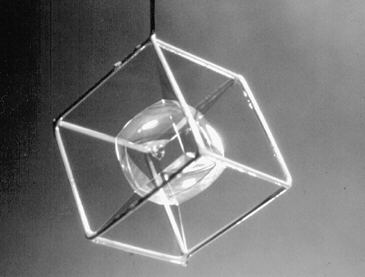
| Architecture and Mathematics: Soap Bubbles and Soap Films |
|---|
Università di Roma "La Sapienza," Rome
and Università "Ca' Foscari," Venice
 When
Joseph Plateau published his treatise on soap bubbles and film
in 1873, soap bubbles already had their own place in literature
and art. Plateau's problem consists in taking a generic curve
in three-space and finding a surface with the least possible
area bounded by that curve. The empirical solution may be obtained
by dipping a tridimensional model of the curve into soapy water,
resulting in a form called a minimal surface. When a soap
bubble is blown, the soapy surface stretches; when blowing ceases,
the film tends toward equilibrium. The sphere presents the least
exterior surface area of all surfaces containing the same volume
of air.
When
Joseph Plateau published his treatise on soap bubbles and film
in 1873, soap bubbles already had their own place in literature
and art. Plateau's problem consists in taking a generic curve
in three-space and finding a surface with the least possible
area bounded by that curve. The empirical solution may be obtained
by dipping a tridimensional model of the curve into soapy water,
resulting in a form called a minimal surface. When a soap
bubble is blown, the soapy surface stretches; when blowing ceases,
the film tends toward equilibrium. The sphere presents the least
exterior surface area of all surfaces containing the same volume
of air.
The isoperimetric property refers to the fact that the circumference encloses the largest surface area. It is reasonable to suppose that people of ancient times in charge of founding a town were aware of the isoperimetric property, at least empirically: A town wall of the least possible length containing the largest area had to be circular. The circular plan is more prevalent in some periods of history than in others. C.N. Ledoux presented a circular plan for a town, the form as "pure as the one the Sun describes in its movement."
Like the circle, the sphere also appears in architecture.
Ledoux planned a spherical house. His contemporary, Boullée,
used the sphere in the cenotaph of Newton. The hemispherical
igloos of the Eskimos solve the problem of a structure based
on a plane with the greatest possible volume for the same external
surface.
Frei Otto used soap film models to design his tensile-structures.
He developed a technique to obtain a precise photogrammetric
evaluation of soap film models and another method to simulate
peaks in a membrane of soap films. Otto's Institute of Architecture,
Stuttgart, was built along the lines of such a model.
H.A. Schwarz solved Plateau's problem for a non-plane boundary by developing the periodic minimal surface. Infinite periodic minimal surfaces, combinations of saddle polygons or surfaces, are more stable. Such a surface has been adapted as a play sculpture in the Brooklyn Museum, where children can actually enter into the labyrinthic structure of periodic minimal surfaces.
|
Michele Emmer, "Architecture and Mathematics: Soap Bubbles and Soap Films", pp. 53-65 in Nexus: Architecture and Mathematics, ed. Kim Williams, Fucecchio (Florence): Edizioni dell'Erba, 1996. http://www.nexusjournal.com/conferences/N1996-Emmer.html |
|
|
|
|
